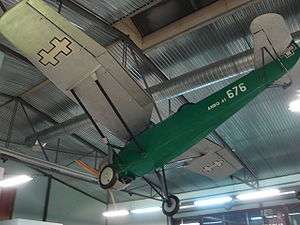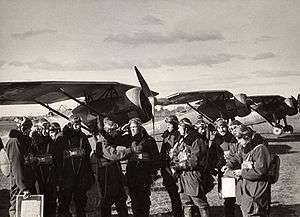ANBO IV
The ANBO IV was a reconnaissance aircraft used by the Lithuanian Air Force in World War II, designed by Lithuanian aircraft designer Antanas Gustaitis. The Lithuanian ANBO 41 was far ahead of the most modern foreign reconnaissance aircraft of that time in structural features, and most importantly in speed and in rise time.[1] All ANBO 41 aircraft were likely destroyed during World War II.[2]
| Anbo IV | |
|---|---|
 | |
| ANBO 41 replica as found at Kaunas Aerodrome | |
| Role | Reconnaissance aircraft |
| Manufacturer | Karo Aviacijos Tiekimo Skyrius |
| Designer | Antanas Gustaitis |
| First flight | 14 July 1932 |
| Introduction | 1934 |
| Retired | 1940 (Lithuania) 1941 (Soviet Union) |
| Number built | 14 ANBO IV, 20 ANBO 41 |
| Developed from | ANBO III |
Development
The ANBO IV was developed from the ANBO III trainer. The design was supervised by colonel Antanas Gustaitis. The first flight took place on July 14, 1932, and the prototype was powered by a Wasp engine. After successful trials, series production began. Thirteen series-built aircraft were powered by British Bristol Pegasus engines and were manufactured by Lithuanian Aircraft State Factory. It could be armed with two pairs of light machine guns and could carry 200 kg of bombs.[3]
Operational history
ANBO IVs were introduced into Lithuanian Air Force in 1934 and shortly before that a few aircraft made demonstration flights in a few European countries: Soviet Union, France, United Kingdom and most Scandinavian countries. Between June 25 and July 29, 1934, three aircraft commanded by colonel Gustaitis flew 10,000 km route.
ANBO IV and ANBO 41 aircraft equipped one and two reconnaissance squadrons respectively in Lithuanian Air Force, at the time of the Soviet Occupation of Baltic Republics in the summer of 1940.
A photo exists showing that at least one Anbo IV or Anbo 41 survived this period and was operated by the Luftwaffe during the German occupation.
Variants

- ANBO IV
- Designation of prototype and 13 serial-built aircraft used for night and day reconnaissance.
- ANBO 41
- Second production version with more powerful engine and three-blade wooden propeller. It was then the only aircraft in Europe to employ a wooden three-blade propeller.
Operators
- Soviet Air Force incorporated Lithuanian units with equipment and personnel.
- Luftwaffe used at least one Anbo 41 captured from the Soviet Air Force for training and liaison purposes in 1941–1942.
Specifications (ANBO 41)
General characteristics
- Crew: two, pilot and observer
- Length: 8.80 m (28 ft 10 in)
- Wingspan: 13.20 m (43 ft 4 in)
- Wing area: 29.0 m2 (312 ft2)
- Empty weight: 1,500 kg (3,310 lb)
- Gross weight: 2,300 kg (5,070 lb)
- Powerplant: 1 × Bristol Pegasus XXIII, 750 kW (1,010 hp)
Performance
- Maximum speed: 360 km/h (220 mph)
- Range: 800 km (500 miles)
- Service ceiling: 9,000 m (29,500 ft)
- Rate of climb: 6.9 m/s (1,360 ft/min)
Armament
- 2 × fixed, forward-firing machine guns
- 2 × flexible machine guns for observer
- Up to 200 kg (440 lb) of bombs
See also
References
- "Paskutinįjį Lietuvos karo aviacijos viršininką prisimenant". www.xxiamzius.lt. Retrieved 27 November 2017.
- "Kur dingo lietuvos tarpukario sparnai? (II)". alkas.lt (in Lithuanian). Retrieved 23 August 2018.
- "ANBO-41 - Lietuvos Aviacijos Istorija 1919 - 1940 m." www.plienosparnai.lt. Retrieved 28 November 2017.
- Taylor, Michael J. H. (1989). Jane's Encyclopedia of Aviation. London: Studio Editions.
- Lithuanian Aviation Museum
External links
| Wikimedia Commons has media related to ANBO IV. |
- Lithuanian description (in Lithuanian)